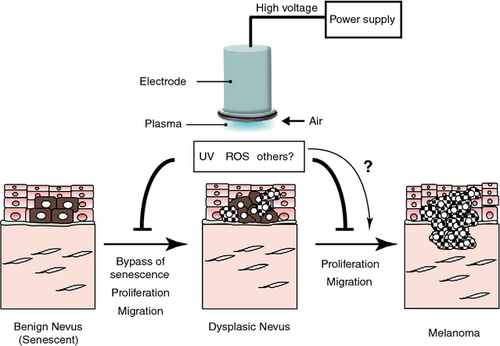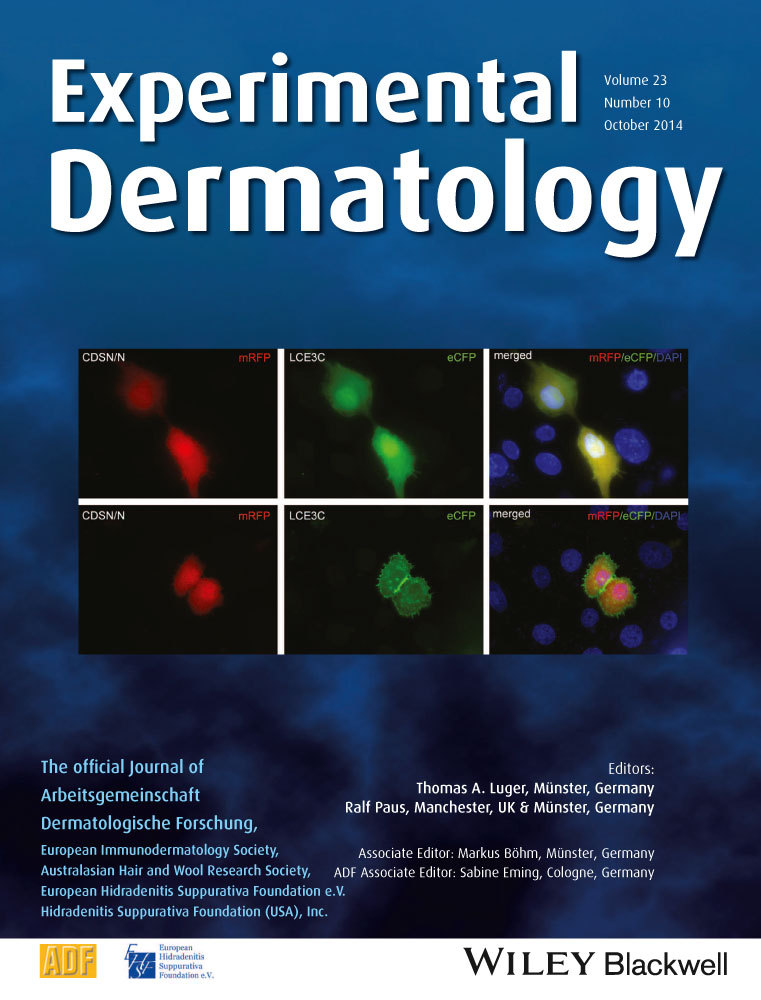Non-thermal plasmas: novel preventive and curative therapy against melanomas?
Abstract
Malignant melanoma is a very aggressive cancer with a very poor short-term prognosis once metastatic. For years, there was no efficient adjuvant therapy after surgery. Chemotherapy and immunotherapy provided hope, but not victory. Further efforts are therefore required, to find new ways to cure this disease. Physics has, once again, opened up new possibilities for treatment, through the use of non-equilibrium atmospheric pressure plasma (NEAPP). The curative potential of this technique was initially assessed on cancer cells, among which melanoma. In a recent issue, Yajima et al. use NEAPP on benign nevi, as a preventive treatment.
Malignant melanoma is one of the most aggressive forms of cancer. The incidence of this cutaneous cancer has increased rapidly over the last 50 years. Nevi and melanomas have been successfully removed surgically for preventive and curative purposes, respectively. However, surgery has its limits due to lack of accessibility, the mass that can be removed and scarring.
Melanoma is highly resistant to other treatments, explaining the lack of effective adjuvant therapies after surgery 1. Recent developments in basic research and drug discovery have led to the transfer of new molecules from bench to bedside. Genetic and epigenetic modifications induce the initiation and progression of melanoma, with an efficient phenotype switch mechanism resulting in natural heterogeneity in melanomas 2, 3. These mechanisms may, together, account for the natural resistance of melanoma to conventional treatments. The current challenge is thus the discovery and development of new preventive and curative therapeutic strategies, to improve melanoma management.
Progress in physics and the application of related technology has, once again, opened up new therapeutic possibilities, namely with the use of non-equilibrium atmospheric pressure plasma (NEAPP). In physics, plasma is the fourth state of matter, in addition to liquids, solids and gases and should not be confused with the biological non-cellular fluid component of circulating blood. Irving Langmuir coined this term for the newly discovered state of matter by analogy to biological plasma, which transports blood cells and particles 4, 5. Plasma is a transitory ionized gas (such as helium, nitrogen, argon or air) generated by a source of energy, typically high voltages or strong electromagnetic field. Physical plasmas may take various forms 6, and it is important to distinguish between thermal and non-thermal plasmas in medical contexts. In thermal plasmas, ionization is very important (high density of ions and electrons) so that the gas temperature is of several thousand degrees. By contrast, non-thermal plasmas (NTP) also named cold atmospheric plasmas (CAP) or even non-equilibrium atmospheric pressure plasmas (NEAPP), as referred by Yajima et al., are almost neutral ionized gases (low density of ions and electrons) generated at low temperature and normal atmospheric pressure 7. In non-thermal plasmas, the temperature of the ionized gas thus remains low.
In medicine, the first use of plasmas involved thermal plasmas. The heat generated by these plasmas was used to sterilize, remove tissues or cauterize, as for lasers. NEAPP have been in use for several years now as an effective decontamination method 8. It has been shown to kill diverse bacterial strains and viruses highly efficiently 9. In addition, the lack of heat production by these plasmas renders this technique suitable for use as an efficient sterilization method for fragile instruments.
NEAPP has also been studied in cultured cell lines and live animals. At the physical and molecular levels, NEAPP generate among others UV and reactive oxygen species 8, 10. At the cellular level, NEAPP increase the migration of fibroblasts in vitro and wound healing capacities in mice 11. NEAPP have a regulatory function on the expression of adhesion molecules that may influence the migratory properties of keratinocytes 12. NEAPP also induce apoptosis of melanoma, breast cancer and pancreatic cancer cells 13-15. In at least some cases, apoptosis induced by NEAPP irradiation is dependent on free radicals generated by mitochondria. Another advantage of NEAPP over thermal plasma is the lack of induction of necrosis and inflammation with this technique.
Depending on their duration and/or the energy applied, NEAPP may also induce the senescence of melanoma cells 13. NEAPP thus constitute an interesting alternative therapy requiring assessment with various types of cancer and improvements in our understanding of the molecular and cellular mechanisms underlying the cellular response. Crucial studies have been performed to increase our knowledge of the mechanisms underlying the use of NEAPP in alternative cancer treatments 16, 17.
In a recent issue of Exp. Derm., Yajima et al. 7 use a previously described mouse melanoma model (HL-RET-mice) to characterize the response of melanocyte tumors to NEAPP treatment. The authors claim that the initiation and progression of melanomas in HL-RET-mice (on a hairless background), mimic those of human melanoma. Yajima et al. show that the treatment of benign melanocytic nevi by NEAPP reduces the growth of subsequent tumors. This effect is correlated with a decrease in the expression of cell cycle mediators (cyclins D1, E1 and E2) and an increase in the expression of the cell cycle suppressor p27KIP1, resulting in an overall cytostatic effect. These results are of particular interest, as they show a clear effect of NEAPP on the proliferative properties of benign tumors. This technique may therefore be useful for the prevention of cancer initiation in patients with large numbers of nevi that cannot be removed surgically.
Interestingly, it has already been shown that cells in S phase are the most sensitive to NEAPP exposure 18. NEAPP treatment also induces the production of ROS, by unknown mechanisms that appear to be dependent on mitochondrial activity. These ROS are responsible for the accumulation of DNA damage during S phase.
In a previous issue of Exp. Derm., it was shown that NEAPP could induce senescence in melanoma cells 13. In their new paper, Yajima et al. show that NEAPP has an antiproliferative effect on benign nevi (Fig. 1). NEAPP thus appears to be a promising therapeutic strategy for the prevention and/or treatment of melanoma. In-depth studies are now required to decipher the exact mechanisms underlying the production of UV rays and unstable chemical compounds (ROS) by NEAPP and other as yet unknown mechanisms potentially involved in the mode of action of the physical plasma, with effects on fundamental cellular mechanisms, such as proliferation, senescence, migration and invasion. Finally, it will be important to show that the dose used, the chronicity of treatment and the type of gas do not have antagonistic effects after NEAPP treatment. We should not forget that UV and ROS may promote transformation, and a full evaluation of the benefits and risks of treatment is thus required. The harmonization and standardization of methods, or at least careful description of the characteristics of the apparatus used, will eventually be required, because NEAPP generators are custom-built and therefore highly heterogeneous. In the future, it may be possible to miniaturize these devices for novel, specific types of microsurgery.

Acknowledgements
FG and LL wrote the manuscript. Our research is funded by LNCC, INCa, ARC, PAIR melanoma, Institut Curie, INSERM, CNRS and Université Paris-Sud. We are grateful to Pierre-Marie Girard (Institut Curie) for helpful discussion and critical reading.
Conflict of interests
The authors have no conflict of interest to declare.




